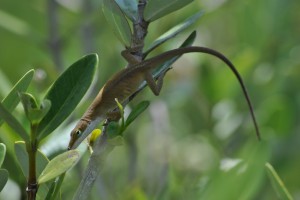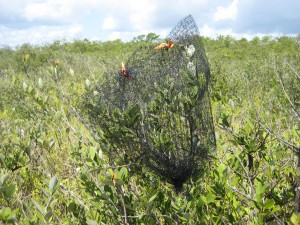by Micah Miles, SERC intern and UMD undergraduate
If you have ever visited coastal Florida, you have probably run across some lizards. Lots of them.

Green anole seen near the Smithsonian Marine Station. Scientists aren’t sure whether anoles are helping or hurting mangroves in Florida. (Micah Miles)
The lizard I see most often, Anolis sagrei, the brown anole, is actually an exotic species. Native to the Caribbean, it was introduced to southern Florida and has gone on to invade northern Florida and parts of Georgia. A number of researchers have investigated the role of the brown anole in its native habitat and have found that brown anoles can have what are called “top-down” effects on local food webs. By eating spiders, anoles can indirectly boost the number of flying insects that would otherwise be spider prey. With more herbivorous insects around, plants can actually suffer more damage when anoles are abundant.
This is where things get interesting. Since most of these studies occurred on Caribbean islands and focused on how anoles affect insect communities, I thought: Why not try something similar in Florida that focuses on the effects of anoles on the health of black mangroves?
Many of the trees down here are rife with herbivore damage. In some of the sites we’ve seen, flower bud herbivory is so extensive that it is hard to find an intact bud on the entire tree. At other sites, evidence of herbivory is rare, possibly due to the immense orb weaver spiders found at almost every tree.

Bird net surrounding a black mangrove. The net lets insects and spiders in, but keeps anoles out–allowing researchers to see what impact anoles are having on mangroves. (Micah Miles)
Of course, whether or not any of these plant characteristics do change depends on what kind of prey brown anoles are eating. There are three possible outcomes here: If brown anoles are mostly preying on spiders, then the netted branches will show less damage than the control—excluding anoles will boost spider numbers, causing the abundance of plant-eating insects to decrease. If brown anoles are mostly eating small, herbivorous insects, then the netted branches will show more damage than the control branches—without the anoles, the herbivores flourish and wreak havoc on the trees. Finally, a third possibility is that I find no difference between the netted and control branches. This could be because anoles just aren’t abundant enough to have top-down effects in this type of mangrove habitat, or because other predators, like spiders, can fill the void when anoles are excluded.
I still spend most days watching for insects and staring at flowers, but now every time that I see an anole, or a spider, or some sort of herbivore damage to the mangroves themselves, I think about my own netted trees and I ask myself: Do I feel like a scientist yet?
More stories from the mangroves >>
This material is based upon work supported by the National Science Foundation under Grant Number 1065821. Any opinions, findings, and conclusions or recommendations expressed in this material are those of the author(s) and do not necessarily reflect the views of the National Science Foundation.


Cool picture! I bet you see alot of these lizards.
We have a good many here in northern South Carolina. check out my picture;
Caterpillars, Insects, Lizards and Newts